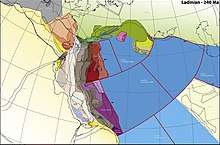Greater Adria
Greater Adria is a Greenland-sized paleomicrocontinent that existed from 240 to 140 million years ago. The paleocontinent is named after Adria, a geologic region found in Italy, where evidence of the microcontinent was first observed.
Research history
The continent was revealed to the public in September 2019. The continent was uncovered through simulations of plate tectonics with the GPlates software.[1][2][3][4]
Geologic history

The continent formed by rifting from the north Africa portion of the supercontinent of Gondwanaland 240 million years ago. It broke free into the Neo-Tethys Ocean and headed towards Laurasia. About 200 million years ago, the microcontinent of Iberia separated from the bulk of Greater Adria. The continent ended up accreting to the south Europe portion of the supercontinent of Laurasia, 140 million years ago. It then began subducting under it 100 million years ago.[1][2][3][4]
Current geography
The Greater Adria now forms parts of the Alps, Apennines, the Balkans, Anatolia, the Caucasus. Including the Iberian microcontinent, it also forms Iberia, the Pyrenees, Occitania. Excluding Iberia, the only part remaining relatively intact is a strip running from Turin and Istria to the heel of Italy, under the Adriatic. Most of the subducted remains are some 1,000 km (620 mi) under Europe, deep in the Earth.[1][2][3][4]
See also
| Look up greater adria in Wiktionary, the free dictionary. |
- Zealandia, a sunken microcontinent under New Zealand
- Mauritia (microcontinent), a sunken microcontinent under Mauritius
References
Further reading
- Douwe J.J. van Hinsbergena; Trond H. Torsvikbc; Stefan M. Schmidd; Liviu C. Maţencoa; Marco Maffioneae; Reinoud L.M. Vissersa; Derya Güreraf; Wim Spakmanab (3 September 2019). "Orogenic architecture of the Mediterranean region and kinematic reconstruction of its tectonic evolution since the Triassic". Gondwana Research. doi:10.1016/j.gr.2019.07.009.